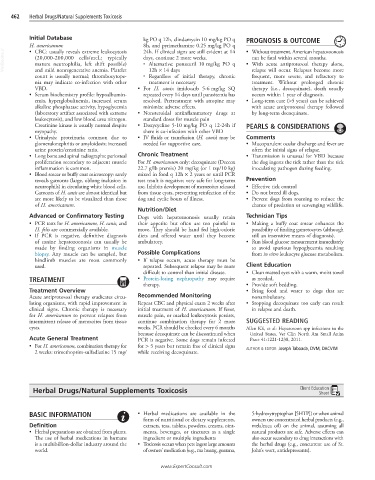Page 941 - Cote clinical veterinary advisor dogs and cats 4th
P. 941
462 Herbal Drugs/Natural Supplements Toxicosis
Initial Database kg PO q 12h, clindamycin 10 mg/kg PO q PROGNOSIS & OUTCOME
H. americanum: 8h, and pyrimethamine 0.25 mg/kg PO q • Without treatment, American hepatozoonosis
VetBooks.ir (20,000-200,000 cells/mcL; typically days, continue 2 more weeks. • With acute antiprotozoal therapy alone,
24h. If clinical signs are still evident at 14
• CBC: usually reveals extreme leukocytosis
can be fatal within several months.
○ Alternative: ponazuril 10 mg/kg PO q
mature neutrophilia, left shift possible)
and mild nonregenerative anemia. Platelet
12h × 14 days
count is usually normal; thrombocytope- ○ Regardless of initial therapy, chronic relapse will occur. Relapses become more
frequent, more severe, and refractory to
nia may indicate co-infection with other treatment is necessary. treatment. Without prolonged chronic
VBD. • For H. canis: imidocarb 5-6 mg/kg SQ therapy (i.e., decoquinate), death usually
• Serum biochemistry profile: hypoalbumin- repeated every 14 days until parasitemia has occurs within 1 year of diagnosis.
emia, hyperglobulinemia, increased serum resolved. Pretreatment with atropine may • Long-term cure (>5 years) can be achieved
alkaline phosphatase activity, hypoglycemia minimize adverse effects. with acute antiprotozoal therapy followed
(laboratory artifact associated with extreme • Nonsteroidal antiinflammatory drugs at by long-term decoquinate.
leukocytosis), and low blood urea nitrogen. standard doses for muscle pain
Creatinine kinase is usually normal despite • Doxycycline 5-10 mg/kg PO q 12-24h if PEARLS & CONSIDERATIONS
myopathy. there is co-infection with other VBD
• Urinalysis: proteinuria common due to • IV fluids or transfusion (H. canis) may be Comments
glomerulonephritis or amyloidosis; increased needed for supportive care. • Mucopurulent ocular discharge and fever are
urine protein/creatinine ratio. often the initial signs of relapse.
• Long bone and spinal radiographs: periosteal Chronic Treatment • Transmission is unusual for VBD because
proliferation secondary to adjacent muscle For H. americanum only: decoquinate (Deccox the dog ingests the tick rather than the tick
inflammation is common. 22.7 g/lb premix) 20 mg/kg (or 1 tsp/10 kg) inoculating pathogen during feeding.
• Blood smear or buffy coat microscopy: rarely mixed in food q 12h × 2 years or until PCR
reveals gamonts (large, oblong inclusion in test result is negative; very safe for long-term Prevention
neutrophils) in circulating white blood cells. use. Inhibits development of merozoites released • Effective tick control
Gamonts of H. canis are almost identical but from tissue cysts, preventing reinfection of the • Do not breed ill dogs.
are more likely to be visualized than those dog and cyclic bouts of illness. • Prevent dogs from roaming to reduce the
of H. americanum. chance of predation or scavenging wildlife.
Nutrition/Diet
Advanced or Confirmatory Testing Dogs with hepatozoonosis usually retain Technician Tips
• PCR tests for H. americanum, H. canis, and their appetite but often are too painful to • Making a buffy coat smear enhances the
H. felis are commercially available. move. They should be hand fed high-calorie possibility of finding gametocytes (although
• If PCR is negative, definitive diagnosis diets and offered water until they become still an insensitive means of diagnosis).
of canine hepatozoonosis can usually be ambulatory. • Run blood glucose measurement immediately
made by finding organisms in muscle to avoid spurious hypoglycemia resulting
biopsy. Any muscle can be sampled, but Possible Complications from in vitro leukocyte glucose metabolism.
hindlimb muscles are most commonly • If relapse occurs, acute therapy must be
used. repeated. Subsequent relapse may be more Client Education
difficult to control than initial disease. • Clean matted eyes with a warm, moist towel
TREATMENT • Protein-losing nephropathy may require as needed.
therapy. • Provide soft bedding.
Treatment Overview • Bring food and water to dogs that are
Acute antiprotozoal therapy eradicates circu- Recommended Monitoring nonambulatory.
lating organisms, with rapid improvement in Repeat CBC and physical exam 2 weeks after • Stopping decoquinate too early can result
clinical signs. Chronic therapy is necessary initial treatment of H. americanum. If fever, in relapse and death.
for H. americanum to prevent relapses from muscle pain, or marked leukocytosis persists,
intermittent release of merozoites from tissue continue combination therapy for 2 more SUGGESTED READING
cysts. weeks. PCR should be checked every 6 months Allen KE, et al: Hepatozoon spp infections in the
because decoquinate can be discontinued when United States. Vet Clin North Am Small Anim
Acute General Treatment PCR is negative. Some dogs remain infected Pract 41:1221-1238, 2011.
• For H. americanum, combination therapy for for > 5 years but remain free of clinical signs AUTHOR & EDITOR: Joseph Taboada, DVM, DACVIM
2 weeks: trimethoprim-sulfadiazine 15 mg/ while receiving decoquinate.
Herbal Drugs/Natural Supplements Toxicosis Client Education
Sheet
BASIC INFORMATION • Herbal medications are available in the 5-hydroxytryptophan [5HTP]) or when animal
form of nutritional or dietary supplements, owners use concentrated herbal products (e.g.,
Definition extracts, teas, tablets, powders, creams, oint- melaleuca oil) on the animal, assuming all
• Herbal preparations are obtained from plants. ments, beverages, or tinctures as a single natural products are safe. Adverse effects can
The use of herbal medications in humans ingredient or multiple ingredients also occur secondary to drug interactions with
is a multibillion-dollar industry around the • Toxicosis occurs when pets ingest large amounts the herbal drugs (e.g., concurrent use of St.
world. of owners’ medication (e.g., ma huang, guarana, John’s wort, antidepressants).
www.ExpertConsult.com

